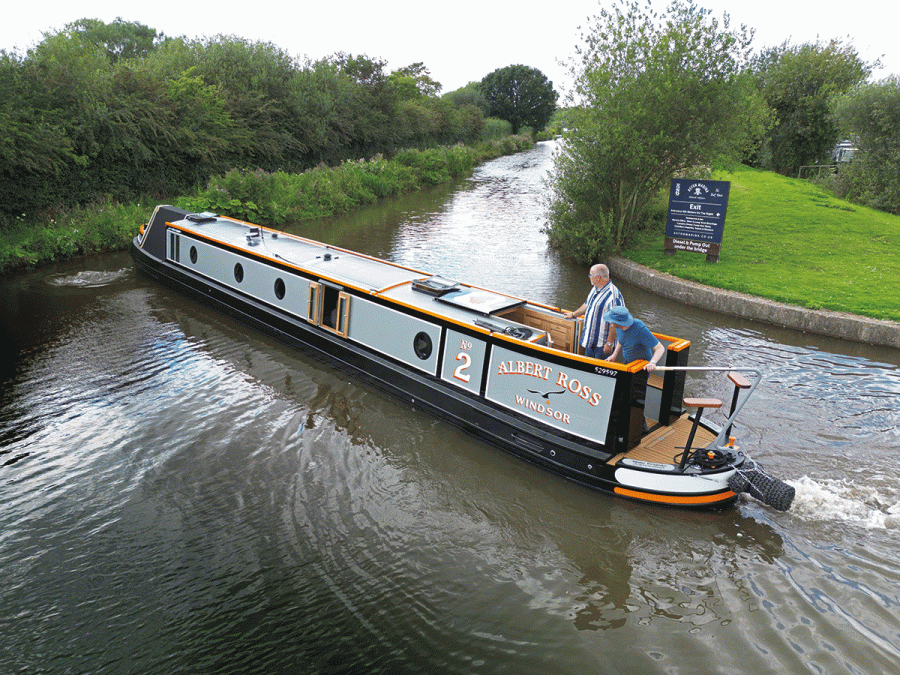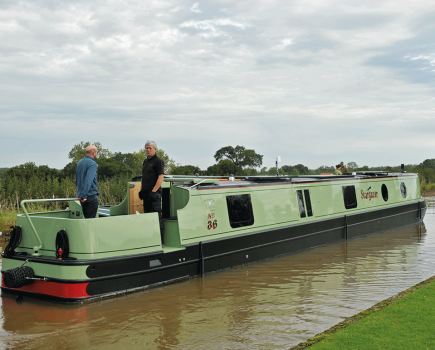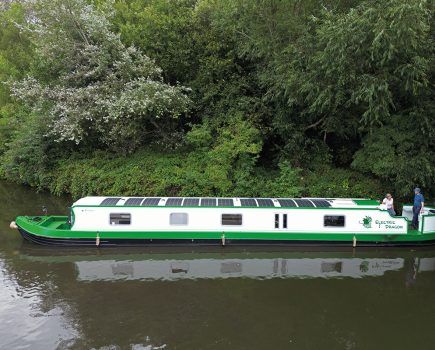One family’s upgrade from a 40ft trad to a brand new 60ft hybrid drive.
Words by Adam Porters | Pictures by Andy Annable
When a family who’ve had a boat for years decides to replace it with a new one, it’s always fascinating to see what decisions they make. Experience shows us all what works for us and what doesn’t – so will they go for something similar, or opt for a complete change?
In the case of Dawn and Tony Ross, they’ve really rung the changes. Their old boat was a 40ft trad which they’ve owned for 20 years, and which didn’t even have the means to provide a 240-volt power supply. Their new boat, Albert Ross, is 20ft longer, has hybrid drive, an exterior which refers back to the shape of working boats, but an interior which is sleek and modern.
The boat has been fitted out by Stone Bespoke Narrow Boats, a company we haven’t featured in a boat test before. They’re relatively new but have plenty of experience, and have fairly recently moved to new premises at Aston Marina. As we’ll see, their work on this boat is impressive.
EXTERIOR
The shell of this 60ft boat is by Nick Thorpe. It follows something of a trend we’ve noticed recently, where the features of old working boats are used to maximise the internal space. There’s no well deck; instead there’s a Potter’s cabin at the bow followed by a tipped in section, made of steel to look like the cloth coverings that cargo boats would have had over their holds. If you want to forego outside space at the bow, then this sort of arrangement is an elegant alternative to just extending the cabin.
The link to working boats has been taken a step further on this boat, because the bow shape is based on a Middle Northwich. These boats were built by Yarwood’s at their yard in Northwich in the mid 1930s for the Grand Union Canal Carrying Company. Only eight pairs were built, making them one of the rarer classes of working boat. A lot of people really like the bow shape, and to replicate it, Nick Thorpe made templates from one of the original boats, a butty called Regulus, which happened to be out of the water so he could see the whole bow. He’s made a pretty good job of it too, and there’s even detailing like the rivets on the stem post. For the stern shape, he looked at motor boats of the same class.
A Middle Northwich wouldn’t originally have had a Potter’s cabin, but history is only an inspiration for a boat like this, and there’s nothing wrong with combining different bits of history. In this case, the Potter’s cabin has nice recessed panels. It’s also practical, because it offers a huge amount of storage space; the water tank is underneath, and helpfully, there are filler points on both sides of the boat. A bulkhead with a planking effect heralds the tipped in cabin section, covered with cloths and traditional ropes.
The semi-trad stern of the boat isn’t nearly so traditional. But there are recessed panels to give the look of a trad – and if you’ve given up your outside space at the bow you really need some at the stern. There’s storage lockers both sides of the deck which double as seats, and they’re nicely scalloped so the rear cabin doors have room to open fully. One locker has a fitting for a dog shower, complete with hot and cold water, so the couple’s two cockerpoos, Stanley and Martha, can be cleaned up after muddy towpath walks.
The use of portholes rather than windows helps maintain the traditional look, along with side doors. The portholes are by Caldwell’s, and are double glazed and have a thermal break. There are more traditional elements on the roof, where there are two glazed pigeon boxes to let in additional light.
The colour scheme is rather dramatic, with black used for the bow and stern. There are also black borders for grey sides, with white coachlines between. Bright orange is used for the handrails, which gives the whole look a contemporary twist; Tony denies having a bit of a thing for orange, but his car is the same colour, so you may want to take those denials with a pinch of salt. The signwriting, including the rather nice silhouette of an albatross, is by Rob Wagg.
LAYOUT AND FITOUT
This is a reverse layout boat, with the galley at the stern. There’s then a Pullman dinette and the saloon. Next comes a walk-through shower room, with the cabin at the bow. This makes use of the tipped in section for the bed itself. The fitout uses painted cabin sides and painted tongue and groove below the gunwales. The panels are spray painted to give the best possible finish. Oak is used for the trim throughout. The entire fitout is good quality. Everything fits together nicely, and the furniture, made in-house, is particularly skilfully done. The floor is hard wearing Karndean, laid with a caulking line, which makes it look even more like real wood.
GALLEY
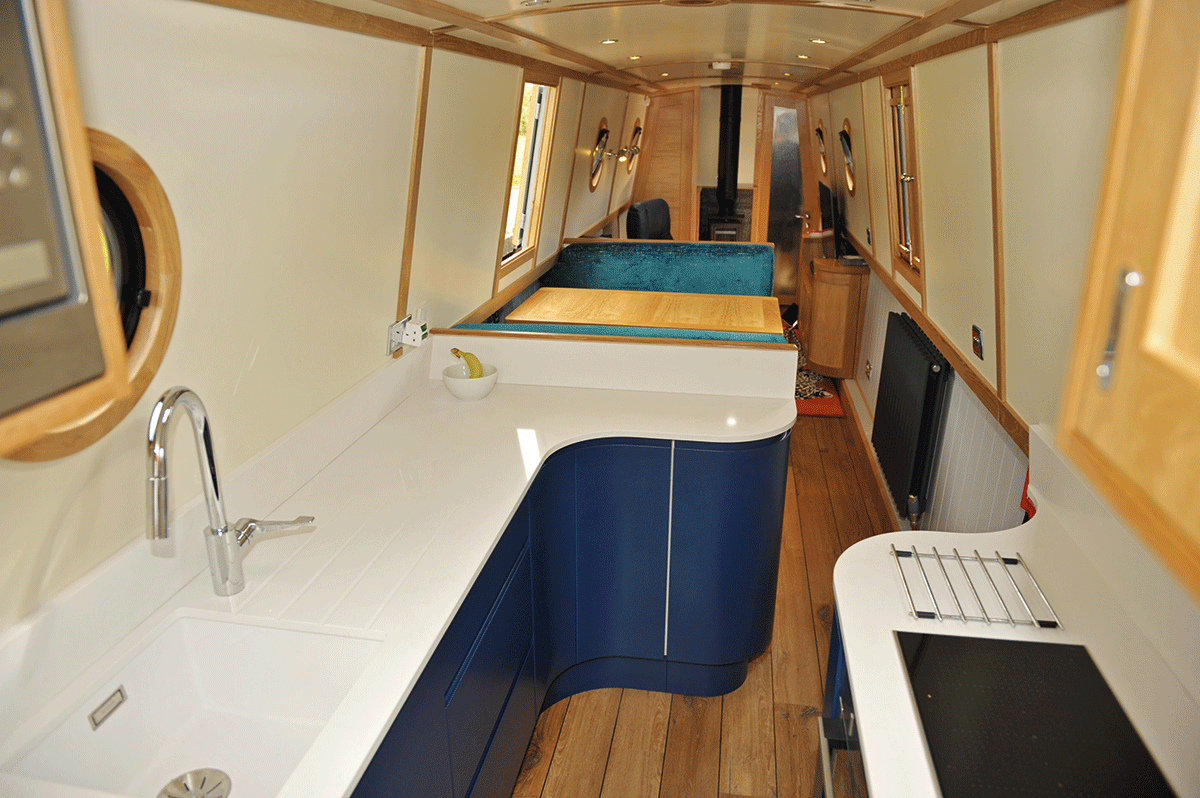 Steps lead down from the stern deck, and have lifting treads for storage. There are little lights to illuminate them too. On one side is the electrical cupboard, while opposite is a cupboard with a finrad in the bottom, to help dry wet coats. Many of the cupboards in this boat have flush handles that pop out when you push them. It means you won’t catch yourself or your clothes on them as you go past; they are more normally seen as handles for pocket doors.
Steps lead down from the stern deck, and have lifting treads for storage. There are little lights to illuminate them too. On one side is the electrical cupboard, while opposite is a cupboard with a finrad in the bottom, to help dry wet coats. Many of the cupboards in this boat have flush handles that pop out when you push them. It means you won’t catch yourself or your clothes on them as you go past; they are more normally seen as handles for pocket doors.
Stone Bespoke Narrow Boats usually build their own galley units, but these ones are bought in, as Dawn was determined to have curved units with curved doors on the ends of the run. The cupboard doors are dark blue, and the worktops are white Quartz. It all looks very stylish. Equipment is of a high level too. There’s a Neff oven with a slide and hide door, a Neff induction hob, and a Bosch microwave. The sink is by Blanco and has a curved tap with a pull nozzle, and there’s a wine store in the floor, where the temperature of canal water keeps it naturally cool.
DINETTE AND SALOON
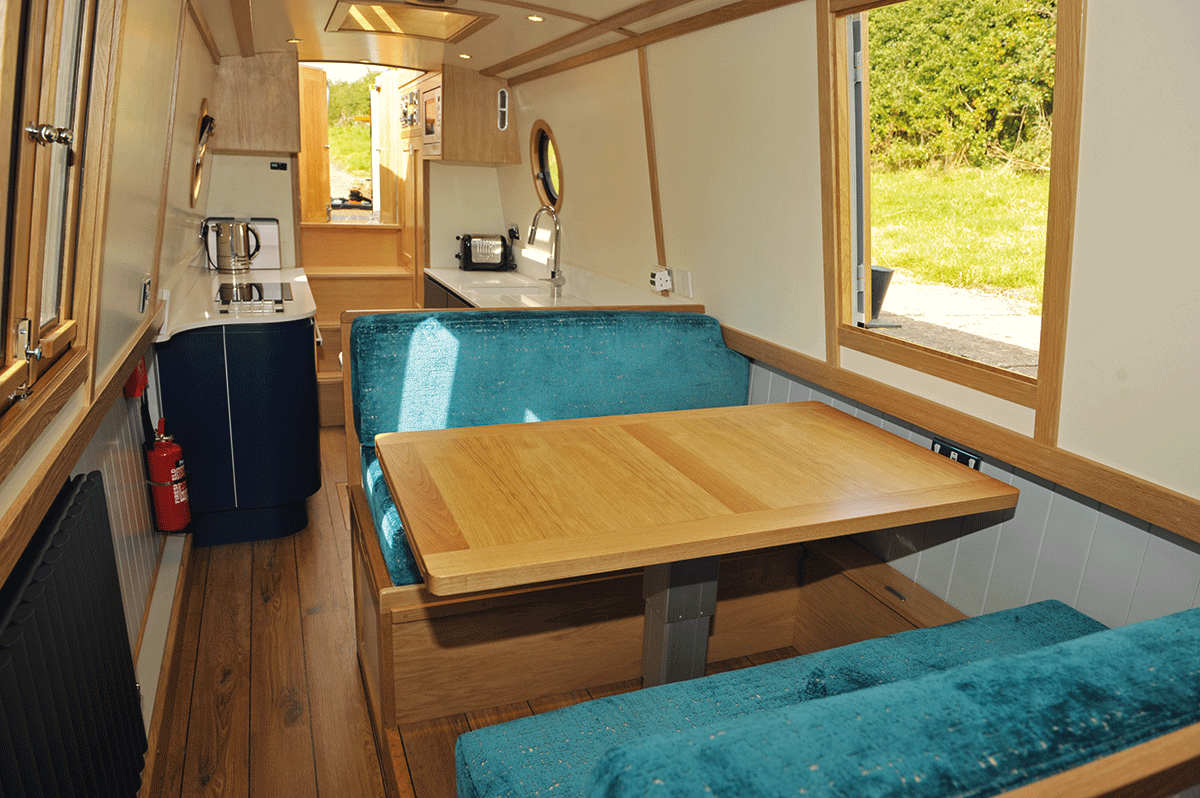 The Pullman dinette has a table that rises and lowers electrically at the touch of a button, meaning converting it into a guest bed is very easy. It’s a very versatile space all round, as there’s a leaf stored underneath which extends the table to the entire width of the boat, so it can easily seat six. The drawers in the ends of the bench seats then pull out, and when you turn the lids over they have cushions built in for extra seating. (There’s also an extra table top stored underneath the dinette, which can be used on the stern deck). The dinette has a built-in magazine rack at the far end too, and there’s a drawer freezer in the potentially dead end of one of the benches, which is accessed from the saloon. Glazed side doors on both sides of the boat make this a very pleasant place to sit.
The Pullman dinette has a table that rises and lowers electrically at the touch of a button, meaning converting it into a guest bed is very easy. It’s a very versatile space all round, as there’s a leaf stored underneath which extends the table to the entire width of the boat, so it can easily seat six. The drawers in the ends of the bench seats then pull out, and when you turn the lids over they have cushions built in for extra seating. (There’s also an extra table top stored underneath the dinette, which can be used on the stern deck). The dinette has a built-in magazine rack at the far end too, and there’s a drawer freezer in the potentially dead end of one of the benches, which is accessed from the saloon. Glazed side doors on both sides of the boat make this a very pleasant place to sit.
Stone Bespoke’s joinery skills are fully on display in the saloon, with an impressive under-gunwale tv unit. It floats off the floor, and has curved doors at each end, to really soften the look. Doors like that are not easy or quick to make (which explains why only these ones were made, not the galley ones too).
The stove is a Hamlet, and has a slate hearth and surround in the centre of the forward bulkhead. The double insulated flue means it meets the current installation guidelines. Between the stove and the cabin sides is a tall cupboard, offering hanging space. Other furniture includes a couple of comfortable captain’s chairs.
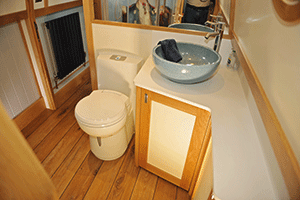 SHOWER ROOM
SHOWER ROOM
When you enter this walk-through shower room, you’re likely to be distracted from the generous 800x700mm cubicle, by the beady eyes of a giant Admiral Flamingo looking at you from inside. The owners had the acrylic shower panel specially printed, because they liked the design; the massive bird definitely wouldn’t be everyone’s ideal shower companion. The company which made it, Rock Salt Prints, have a range of dramatic designs on offer, and can make shower walls to any design, any shape, and any size. On a more mundane level, access to the shower pump is via the storage space between the cubicle and the hull side.
A smart mid-blue crackle-glazed basin sits on a quartz worktop on a corner unit which provides storage, and there’s a mirror wall behind. The loo is a Thetford cassette, and there’s a trendy zigzag towel rail.
CABIN
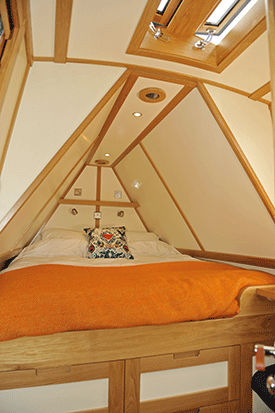 This is an exceptionally comfortable and well appointed space. The bed is in the tipped in section of the boat, meaning it’s a full king-size. But with the sloping walls, the space also feels very cosy and intimate. There’s a shelf above the head of the bed with reading lights, and several charging sockets and USBs. The base of the bed has drawers in the end, and there’s even a pull-out laundry bin.
This is an exceptionally comfortable and well appointed space. The bed is in the tipped in section of the boat, meaning it’s a full king-size. But with the sloping walls, the space also feels very cosy and intimate. There’s a shelf above the head of the bed with reading lights, and several charging sockets and USBs. The base of the bed has drawers in the end, and there’s even a pull-out laundry bin.
While there are no windows by the bed itself, the room is flooded with light thanks to a doubled glazed pigeon box in the ceiling, and glazed side doors on either side of the boat. As there is no bow access, these also double as emergency escape routes. Below one of the sets of doors is a dressing table, but it’s also set up with power sockets and USB ports, so it can double as a desk. The drawers have nice recessed handles. With a water view right outside, it would make a very nice place to work, if perhaps a little distracting! The boat is fitted with a 5G router, so connectivity should be good.
TECHNICAL
There are two types of hybrid systems available for boats, serial and parallel. We’ve seen several examples in these boat tests over the past few months of serial hybrids – their propulsion is by an electric motor, and they have a diesel generator to charge the batteries (usually alongside solar). This boat has a parallel hybrid system, with both a diesel engine and an electric motor, either of which can turn the prop. The cons of a parallel system are that an engine is generally bigger than a generator, and is less efficient at generating electricity. The pros are that you have options – you can turn your prop with electrical power if you have it available, or diesel power if you haven’t. And if you’re on a fast flowing river, for example, you might feel more comfortable with the grunt of a diesel under your feet. This boat has the system from Hybrid Marine. We’ve seen many of these over the years based on the familiar Beta 43 engine, but this one uses a Barrus Shire 45. The electric motor is a 10kw unit, which turns into a 5kw charger when the engine is running.
The enhanced package fitted to Albert Ross has a battery bank of 24 two-volt lead acid traction cells, totalling 800Ah at 48 volts. That’s plenty for both propulsion and cooking. The batteries are big and heavy, and are situated across the boat, under the top step from the stern deck. They are vented over board, and have an automatic watering system to ease topping up. A 240-volt supply comes from an 8kw Victron inverter charger, and there’s a cross charging system for the 12-volt circuit, which includes things such as lights and pumps. In addition to the engine, charging of the batteries comes from three large solar panels on the roof, giving an array of around 1kw. The boat can also, of course, be plugged into shore power.
There is a Victron control system which monitors everything. There’s a display in the boat, and it comes with a smartphone app, so you can see remotely what’s going in and out of the batteries.
The boat also has a remote control system, which can operate not only the electric motor, but the Vetus 95kgf bow thruster. It means you could steer the boat from the bank, but would probably be most useful if you were single handing through locks.
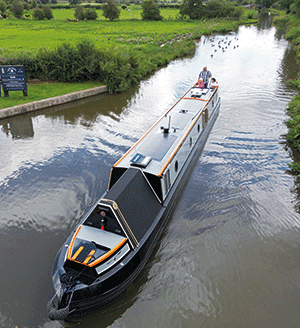 ON THE WATER
ON THE WATER
The benefits of electric cruising are clearly that the peace and quiet of the countryside are undisturbed by the noise of a diesel engine. Tony says he plans to use electric propulsion as much as possible, and hopes to switch to diesel very infrequently. When underway, all you can really hear is the sound of the water round the prop, and trickling along the side of the boat. On a sunny day, there’s a good chance the solar panels will be making as much power, if not more, as you need to cruise.
Another advantage of electric power is that you can move extremely slowly, which is great for when you need to come alongside the bank, or in tight situations. You can go much slower than a diesel engine’s tickover, for example, but still have some steerage.
CONCLUSION
This is a really lovely boat. On the outside it looks dramatic and interesting; on the inside it’s both stylish and welcoming. And in terms of technology, it has the flexibility that a parallel hybrid offers. If you wanted a boat like this now, the price would be around £245,000; that sounds like good value for money in a market where we’ve seen several boats recently who’ve prices have begun with a 3.
The work of Stone Bespoke Narrow Boats is impressive too. This is clearly a quality fitout by craftsmen who know what they’re doing. And they’ve worked with owners who had a vision of something completely different from what they already had, and have been able to deliver it, with style.
STONE BESPOKE NARROW BOATS
Stone Bespoke Narrow Boats consists of the two-man team, Ashley and Martin. They met about four years ago while each working as sub-contractors on a boat. Ashley does the carpentry (he’s a joiner by training), while Martin is in charge of engineering and electrical (he previously worked for big companies in the motor and aerospace industries, on electronics). They liked each others work, and decided to set up together.
They began building their boats in a farmyard, then progressed to a cow shed. But they recently took on a unit at Aston Marina on the Trent & Mersey Canal in Staffordshire. “The quality of our surroundings didn’t match the quality of our boats” says Martin, “so we needed to move somewhere more professional”.
The new location means the firm can also do repaints and blacking, and does a limited amount of service appointment too, as long as they don’t get in the way of boat building. The firm’s aim is to become one of the big names for quality bespoke boat building, and from what we’ve seen there’s no reason why they couldn’t achieve it.
The Owners
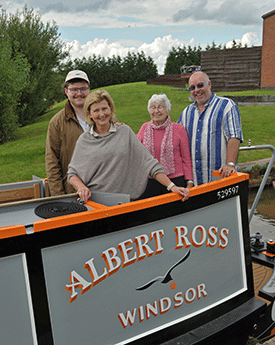 Dawn and Tony Ross decided to upgrade their boat when they made a big change to their lives. They ran their own firm of financial advisers, but have sold the business and stopped work.
Dawn and Tony Ross decided to upgrade their boat when they made a big change to their lives. They ran their own firm of financial advisers, but have sold the business and stopped work.
They used their old boat a lot, both as an escape and for holidays with their two children when they were growing up. And family is important to them. On the day we did the test, they’d had a three generation outing to show off the new boat to Tony’s mum, Diana, and one of their sons, Archie. The humour of the boat’s name, Albert Ross, means it too is part of the family.
Specification
Length: 60ft
Beam: 6ft 10in
Shell: Nick Thorpe 07933 769286
Style: Semi-trad
Fit-out: painted panels and oak
Engine: Hybrid Marine www.hybrid-marine.co.uk
Inverter: Victron 8kw www.victronenergy.com
Bow Thruster: Vetus 95kgf www.vetus.com
Shower Wall: Rock Salt Prints www.rocksaltprints.com From £459
Basin: The Way We Live www.thewaywelivelondon.com £489
Pocket door handles: SDS London www.sdslondon.co.uk £8.84 each
Towel rail: Milano Select www.bigbathroomshop.co.uk £199.99
£245,000
CONTACT
Stone Bespoke Narrow Boats
Aston Marina
Lichfield Road
Stone
Staffordshire ST15 8QU
stonebespokenarrowboats@gmail.com
07939 089776
www.stonebespokenarrowboats.com
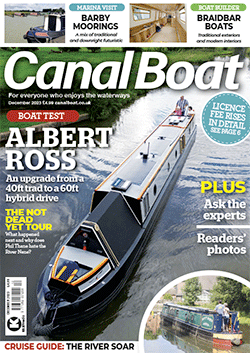 As featured in the December 2023 issue of Canal Boat. Buy the issue here
As featured in the December 2023 issue of Canal Boat. Buy the issue here

